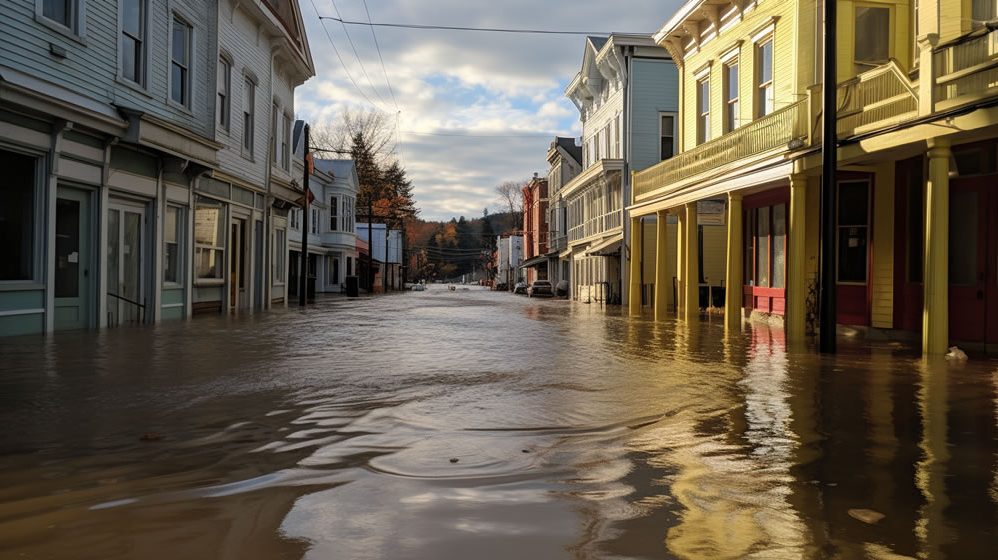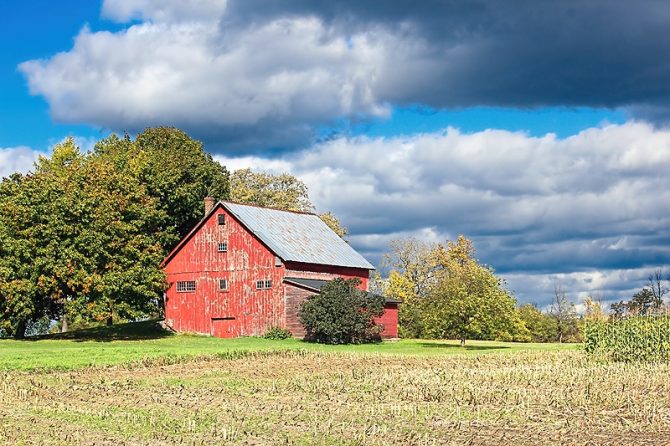In July 2023, Vermont was struck by a catastrophic flood that caused extensive damage to homes, businesses, the Montpelier state capital and infrastructure across the state, including parts of southern Vermont. The flood is considered one of the worst natural disasters in Vermont's modern history, and its impact is still being felt to this day. Without a doubt, the severe flood damage this year due to torrential rains in July, caused vast damage to bridges and other infrastructure. It is said that two months of rain fell as rain in two days.
A Catastrophic, Massive Flood Assimilates the Winooski River in Montpelier, Vermont
The flood of July 23 in VT was the result of a combination of factors, including heavy rainfall, flash floods caused by Tropical Storm Irene, and overflowing river banks. The floodwaters swept through small towns and cities, causing damage to roads, buildings, and homes. In downtown Montpelier, Vermont's small capital city, the damage was particularly severe, with many businesses and historic buildings being destroyed. Months of rain in two weeks as Vermont's capital city and Vermont emergency management teams and moved quickly to contain the damage.
Cresting at 20.88 feet, the surging Winooski River in Montpelier (just one of several major flood events around Vermont) reached its highest point since 1927 during the torrential flooding on Monday night. The rampaging waters far exceeded the levels seen when Tropical Storm Irene brought ruinous flooding to Vermont in 2011. Only the devastating inundation of 1927 saw the Winooski wreak more havoc in Montpelier than it did this week.
The flood was a wake-up call for Vermonters, highlighting the growing threat of extreme weather events and the need for better disaster preparedness measures. In the aftermath of the flood, recovery efforts have been ongoing, with communities coming together to rebuild and strengthen their resilience in the face of future disasters. Vermont's small capital city moved quickly to contain the damage, including a bookstore in Vermont's small capital.
“Make no mistake, the devastation and flooding we’re experiencing across Vermont is historic and catastrophic, Governor Phil Scott said: “Although the comings days, weeks and months will be incredibility difficult, we’ve faced challenges before, and Vermonters have risen to meet the moment. Whether during Irene, COVID or other hardships, Vermonters have proven time and time again we’re willing and able to step up and help our neighbors”
Vermont public safety commissioner Jennifer Morrison encouraged Vermonters to reach out to local leadership if they feel assistance is needed in their communities.
Key Takeaways:
- The 2023 Vermont Flood waters caused extensive damage to homes, businesses, and infrastructure across the state.
- The flood was caused by heavy rainfall, flash floods, and overflowing river banks.
- The flood highlighted the need for better disaster preparedness measures and community resilience in the face of extreme weather events.
The Era of Increasing Extreme Weather Events
Extreme weather events are becoming more likely and more severe in recent years, and Vermont is no exception. The state has experienced an increase in the frequency and intensity of extreme weather events, including heavy rainfall and severe storms. Some claim that flooding in Vermont was likely due to climate change, which is blamed as causing flood events around the globe.
According to the National Oceanic and Atmospheric Administration, and National Weather Service, the Northeast region of the United States has seen a 71% increase in the frequency of extreme precipitation events since the early 1900s. This increase in heavy rainfall events has put a strain on Vermont's aging infrastructure and increased the likelihood of flash flooding.
The Impact on Vermont
The effects of extreme weather events such as the major flood stage on Vermont have been devastating. The state has experienced a number of high-profile natural disasters in recent years, including the 2023 Vermont Flood, which was one of the worst natural disasters in the state's history.
July caused what some saw as up to nine inches of rain, comparable to a natural disaster since a 1927 flood. Many areas of Vermont, other than just Montpelier, were severely impacted by the flood.
The unrelenting rains dumped over 6 inches on the town of Weston in southern Vermont, with neighboring communities like Ludlow, Londonderry and Andover also bearing the brunt of the storm's fury. By Tuesday, state officials had singled out these waterlogged towns as among the most ravaged by the torrential flooding.
Shifting their focus northward on Wednesday, state emergency responders spotlighted Lamoille County as another area of major concern. Raging floodwaters continued to endanger Jeffersonville in the Cambridge region, where heroic swift water rescue efforts were still ongoing. Other northern settlements likely remained at risk, their residents anxiously waiting for the waters to recede.
Bill Fraser, Montpelier city manager, of Vermont said at a news conference that a nearby dam remained a concern but that the city was shifting to a recovery mode and town employees would start removing mud and debris from downtown streets. “The dam did not spill over. The water in the dam is still up there, but it stabilized,” Fraser said
In addition to causing significant property damage and loss of life, extreme weather events have also disrupted Vermont's agricultural industry. Heavy rainfall and droughts have led to decreased crop yields and increased risk of soil erosion, threatening the livelihoods of many Vermont farmers.
The Need for Preparedness
As extreme weather events become more frequent and severe, it is clear that Vermont must be better prepared to withstand their impact. This includes investing in infrastructure that is resilient to extreme weather, as well as establishing emergency response plans that can be quickly activated in the event of a natural disaster.
In addition, the Vermont public rescue, Vermont department and emergency management officials, individuals and communities must take steps to prepare for the impact of extreme weather events. This includes creating emergency kits, securing property, and staying informed about weather conditions and evacuation routes.
Ultimately, by prioritizing disaster preparedness and community resilience, we can help Vermont weather the storms of the future and ensure the safety and well-being of all its residents in their homes.
The Devastating Impact of the 2023 Vermont Flood
We cannot underestimate the severity of the 2023 Vermont July Flood that caused widespread damage and destruction throughout the state. The disastrous flood was linked to the torrential rains and flash flooding that followed in the wake of Tropical Storm Irene. The 2023 flood, deemed as Vermont’s worst natural disaster in living memory, ravaged homes, businesses, public infrastructure, and agricultural lands alike. Many families were displaced from their homes.
The flooding was particularly severe in the towns and villages located near the Winooski River, including Montpelier, Vermont's capital. The river banks were overloaded with unprecedented amounts of water, causing it to overflow and damage the surrounding communities. Apart from the immediate loss of life and property, the floodwaters left a thick layer of mud, silt, and debris behind. The cleanup efforts required the coordinated efforts of government agencies, emergency responders, and volunteers in the aftermath of the disaster.
Flash flooding is not a new phenomenon in Vermont, and the state has a long history of dealing with natural disasters. In 1927, Vermont experienced its worst natural disaster when the Great Flood submerged the entire state. However, the 2023 flood was unique in its severity, and the region was ill-prepared to handle its devastating impact.
Assessing the Damage: Montpelier and Beyond
The 2023 Vermont Flood was undoubtedly the worst natural disaster to hit the state in recent memory. The flood caused widespread destruction and damage to numerous communities, including the small capital city of Montpelier.
As the floodwaters receded, the full extent of the damage became clear. Homes and businesses had been destroyed, roads and bridges were washed away, and landscapes had been radically altered. In Montpelier alone, the damage was estimated to be in the millions of dollars.
| City/Area | Damage Estimate |
|---|---|
| Montpelier | millions of dollars |
| Burlington | over $10 million |
| Brattleboro | $2.7 million |
The damage wasn't limited to Montpelier, however. Throughout Vermont, other areas were hit just as hard if not harder. Communities along the Winooski River, which runs through the center of the state, were particularly impacted. The river flooded over its banks, inundating towns and causing widespread damage. The storm dumped piles of debris in it's wake.
Despite the massive destruction, and river flooding, the people of Vermont came together to help one another. Neighbors helped neighbors and volunteers from across the state and the country traveled to Vermont to assist with the cleanup effort. The community's resilience and determination were truly remarkable.
Montpelier's Recovery Efforts
Montpelier is a small city, but it was hit hard by the flood. The downtown area, which is situated near the Winooski River, was particularly impacted. Businesses were destroyed, and many homes were left uninhabitable.
Despite the devastation, the people of Montpelier wasted no time in beginning the recovery process. The city worked closely with state and federal agencies to secure funding for the repairs and rebuilding efforts. Thanks to this collaboration and the hard work of city officials and volunteers, Montpelier was able to mobilize the resources needed to recover from the disaster.
One of the biggest challenges that faced the city was the need to rebuild its infrastructure. Roads and bridges had been washed away, making it difficult for residents to access critical services. Through a combination of state and federal funding, the city was able to rebuild these vital links, ensuring that Montpelier residents had access to the resources they needed.
Despite the challenges, Montpelier emerged from the disaster stronger than ever. The city's resilience was truly inspiring, and it serves as a testament to the strength of the Vermont community as a whole. Efforts to rebuild in an era when the future weather patterns are uncertain, throughout communities in Vermont, are essential for public safety.
Recovery Efforts and Community Resilience
Following the catastrophic 2023 Vermont Flood, response and recovery efforts have been ongoing to help those impacted by the disaster. The federal emergency management agency (FEMA) has provided assistance along with Vermont officials to homeowners and businesses affected by the flood, while flood insurance has also been crucial in helping people get back on their feet.
Despite the devastating impact of the rain and flooding, Vermont communities have shown incredible resilience in the face of this disaster. Local volunteers have stepped up to help with cleanup and rebuilding efforts, while businesses and organizations have come together to support those who have been affected.
Community Support
The outpouring of community support has been nothing short of inspiring. In Montpelier, local restaurants and shops have offered free meals and supplies to flood victims, while volunteers have helped to remove mud and debris from damaged homes. Officials said that efforts to repair and rebuild near the state capital building and area businesses would continue. Vermont's flooding was just one more challenge to many businesses such as a beloved bookstore in Vermont's small city.
Other communities across Vermont have also come together to support those impacted by the flood. Donations of food, clothing, and other essentials have been collected and distributed to those in need, while fundraisers have been held to help with rebuilding efforts.
Reminiscent of Tropical Storm Irene in 2011
In late August 2011, Tropical Storm Irene brought devastating flooding to the state of Vermont. Sustained rains from the remnants of Irene saturated the ground and caused rivers and streams to overflow their banks, resulting in flash flooding across the region.
On August 28th, several inches of rain fell in just a few hours, washing out roads, bridges, and rail lines. Mendon Brook in central Vermont raged with floodwaters, swallowing up homes, cars, and parts of Route 4. Further north, the swelling Ottauquechee River collapsed a 155-year-old covered bridge in Bridgewater.
Across Vermont, over 500 roads were damaged and several communities were completely cut off. In Wilmington, residents became stranded as floodwaters isolated the small town. A dozen homes dislodged from their foundations and floated downriver.
Widespread power outages left over 75,000 Vermont residents without electricity. Significant flooding and storm damage was reported in towns like Brattleboro, Bennington, Rutland, and Barre.
Tropical Storm Irene proved to be the state's worst natural disaster since the Flood of 1927. Thirty-five Vermont communities were declared federal disaster areas. Damage estimates exceeded $700 million, but Vermont has since rebuilt stronger and more flood resilient.
Future Preparedness
While recovery efforts continue, it is important to also focus on future preparedness to mitigate the impact of extreme weather events like the 2023 Vermont Flood. Adapting to climate change and investing in infrastructure that can withstand severe weather conditions will be crucial in protecting communities in the future. Flood watches should continue and bridges and other infrastucture should be monitored when severe storms are forecast.
It is also important for individuals and businesses to take steps to prepare for future disasters. This may include reviewing and updating flood insurance policies, conducting regular maintenance on homes and buildings, and having an emergency plan in place.
By working together and taking proactive steps towards preparedness, we can build a more resilient Vermont that is better equipped to face the challenges of extreme weather events.
Exploring the Factors Behind the Severe 2023 Flood Damage:
There were several factors that contributed to the severity of the flood damage following the 2023 Vermont Flood. One of the most significant factors was the torrential rains that fell over several days, causing rivers and streams to overflow their banks. The Winooski River, in particular, was a major culprit, inundating homes and businesses in Montpelier and other towns along its banks.
Additionally, the proximity of communities to the river played a role in the severity of the damage. Many of these communities were built on or near floodplains, which increase the likelihood of flooding during extreme weather events. The combination of heavy rains and the proximity of communities to the river created a perfect storm of sorts, resulting in catastrophic flooding and widespread damage.
In addition to these factors, the legacy of past floods also played a role in the severity of the damage. Specifically, the devastation caused by Tropical Storm Irene in 2011 left many communities vulnerable to future flooding. While efforts were made to bolster flood defenses and improve emergency preparedness, these measures proved insufficient in the face of the 2023 Vermont Flood.
However, it's important to note that these factors do not necessarily guarantee severe flood damage in the future. By taking steps to better prepare for extreme weather events, such as improving flood defenses and implementing zoning regulations to limit development in flood-prone areas, we can reduce the impact of future floods and protect our communities.
Remembering the Great Flood of 1927
As we reflect on the catastrophic 2023 Vermont Flood, it's important to remember that this is not the first time our state has faced such devastation. In fact, Vermont experienced one of its worst natural disasters in 1927, when a series of storms caused widespread flooding and destruction throughout the region.
The Great Flood of 1927 left nearly the entire state underwater, with riverbanks overflowing and dams collapsing under the immense pressure. Towns were completely wiped out, and thousands of homes and buildings were destroyed. The disaster had a lasting impact on Vermont, leading to major changes in our infrastructure and emergency response systems. Communities suffered more severe flood damages caused by the 1927 flood that killed dozens of people
While the 2023 Vermont Flood was certainly a devastating event, we can take comfort in the fact that our state has faced such challenges in the past and come out stronger because of it. We must continue to learn from our history and work together to build a more resilient and prepared Vermont for the future.
Steps to Take in the Aftermath of the 2023 Flood
Dealing with the aftermath of a catastrophic flood can be overwhelming. Here are some practical steps to take:
- Contact your insurance company: Call your insurance company as soon as possible to report the damage. Be sure to take photos and document the extent of the damage before beginning any cleanup efforts.
- Pull damaged books and papers: If you have any important documents that have been affected by the flood, remove them from the water and place them in a safe, dry area to prevent further damage.
- Shovel out the mud: Once the water has receded, it's important to remove as much mud and debris as possible. This will help prevent mold and other forms of secondary damage. Use shovels and buckets to remove debris and dispose of it properly.
- Sanitize affected areas: Disinfect all affected areas and surfaces to prevent the growth of harmful bacteria and mold. Wear gloves and a mask to protect yourself while cleaning.
- Consider hiring a professional: Depending on the extent of the damage, you may want to consider hiring a professional cleaning and restoration company to assist with the cleanup process. They have the necessary equipment and expertise to get the job done safely and efficiently.
Remember, recovering from a flood takes time and effort. Take things one step at a time and don't hesitate to reach out for help if you need it. We're all in this together.
Vermont's Resilience and Future Preparedness
As a community, we have shown remarkable resilience in the aftermath of natural disasters like the 2023 Vermont Flood. However, we must also plan for the future and take steps to adapt to the increasing likelihood of extreme weather events. The worst similar disaster since a 1927 flood is a reminder that it can happen again, at any future time.
One important aspect of preparing for natural disasters is community resilience. This means building strong relationships among community members and organizations, establishing emergency plans, and ensuring that everyone has access to the resources they need in times of crisis.
It is also crucial to invest in future preparedness efforts. This includes improving infrastructure to better withstand flooding and other natural disasters, as well as providing education and training to individuals and businesses on how to prepare for and respond to emergencies.
Another important aspect of future preparedness is adapting to the changing climate. This may require changes in land use and development practices, as well as efforts to reduce greenhouse gas emissions and mitigate the impact of climate change on our communities.
We must also ensure that individuals and businesses have access to flood insurance and other forms of federal emergency management support to aid in the recovery process.
By taking these steps, we can work together to build a stronger, more resilient Vermont that is better prepared for the challenges of the future.
Conclusion
As we have seen, the catastrophic 2023 Vermont Flood caused massive damage and served as a stark reminder of the increasing frequency and severity of extreme weather events around the world. The devastating impact of the flood was felt throughout Vermont, with Montpelier and other areas experiencing some of the worst damage from river flooding and flash floods.
Despite the immense challenges posed by the disaster, Vermonters have shown remarkable resilience and determination in the ongoing recovery efforts. With the help of flood insurance, federal emergency management, and other resources, communities are working hard to rebuild and adapt to the new reality of extreme weather.
Looking to the future, it is clear that we must continue to prioritize disaster recovery and preparedness efforts in order to protect our communities and reduce the impact of future natural disasters. By taking steps to address the factors that contributed to the severity of the 2023 Vermont Flood, such as torrential rains and the proximity of communities to the Winooski River, we can work towards building a more resilient and sustainable future.
Q: What caused the 2023 Vermont Flood?
A: The 2023 Vermont Flood was caused by several days of flash flooding.
Q: How much damage was caused by the flood?
A: The flood caused massive damage throughout Vermont, with Montpelier, the state's capital, being one of the most severely affected areas.
Q: What is the significance of the Great Flood of 1927?
A: The Great Flood of 1927 is remembered as Vermont's worst natural disaster, and it serves as a historical reference point for the devastation caused by extreme flooding.
Q: What steps should be taken in the aftermath of the flood?
A: After the flood, individuals and businesses should contact their insurance companies, remove damaged belongings, and initiate cleanup efforts by shoveling out the mud.
Q: How can Vermont prepare for future extreme weather events?
A: Vermont can prioritize community resilience and invest in future preparedness efforts to better adapt to and mitigate the impact of extreme weather events in the future.
Thank you for reading this post, don't forget to subscribe to our email list for the latest news!





